A&P and Microbiology: Diseases and Disorders of the Circulatory System
VerifiedAdded on 2022/09/22
|5
|1007
|15
Report
AI Summary
This report provides a comprehensive overview of two significant circulatory system disorders: coronary artery disease and aneurysm. It delves into the causes, symptoms, diagnostic procedures, and treatment options for each condition, including lifestyle modifications and medical interventions. The report also considers the impact of these diseases at different stages of life, highlighting risk factors and age-related changes in the circulatory system. Furthermore, the report incorporates visual aids to enhance understanding and provides a list of credible sources for further research, offering a valuable resource for students studying the circulatory system and related health issues. The report emphasizes the importance of early detection and management of these conditions to improve patient outcomes.
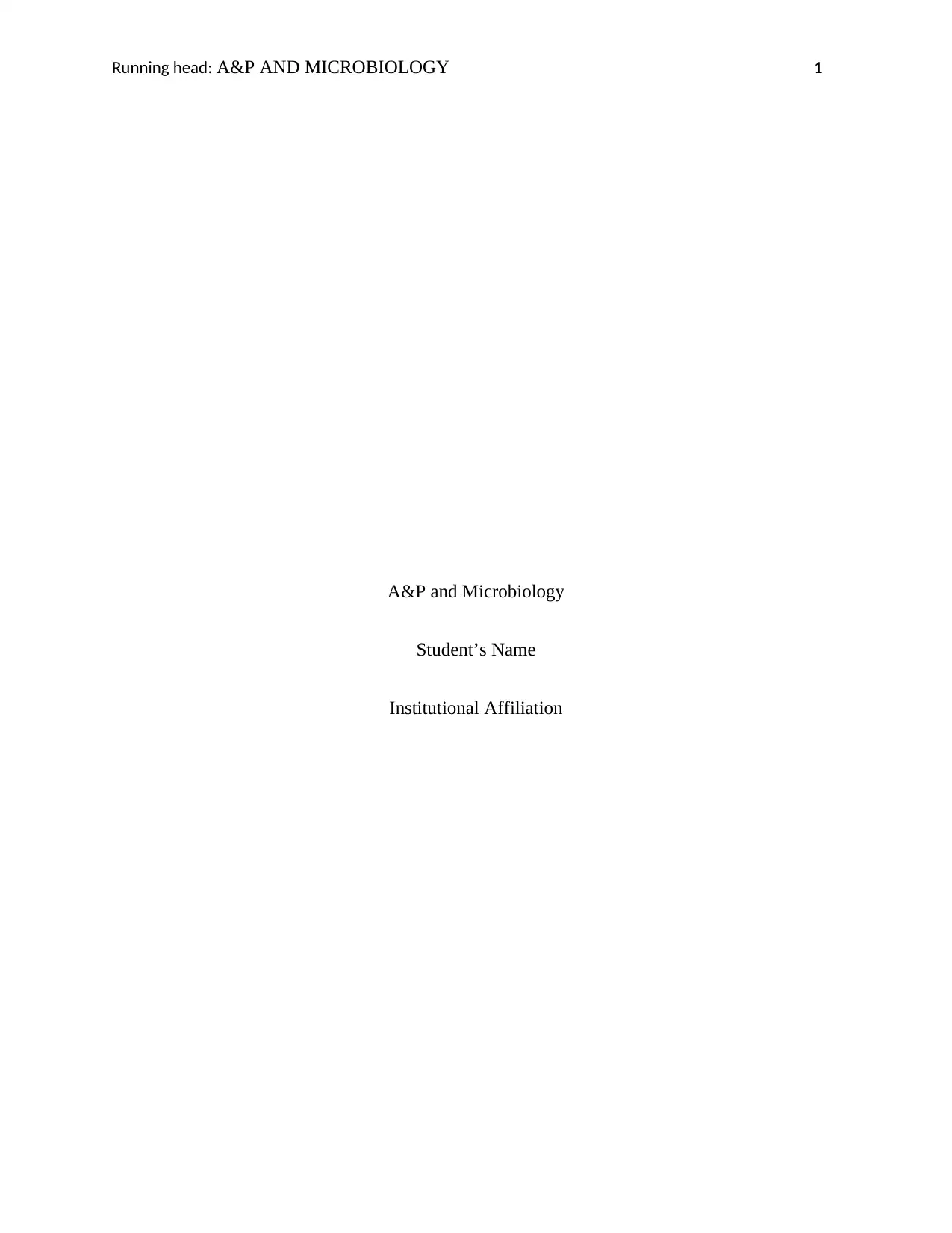
Running head: A&P AND MICROBIOLOGY 1
A&P and Microbiology
Student’s Name
Institutional Affiliation
A&P and Microbiology
Student’s Name
Institutional Affiliation
Paraphrase This Document
Need a fresh take? Get an instant paraphrase of this document with our AI Paraphraser
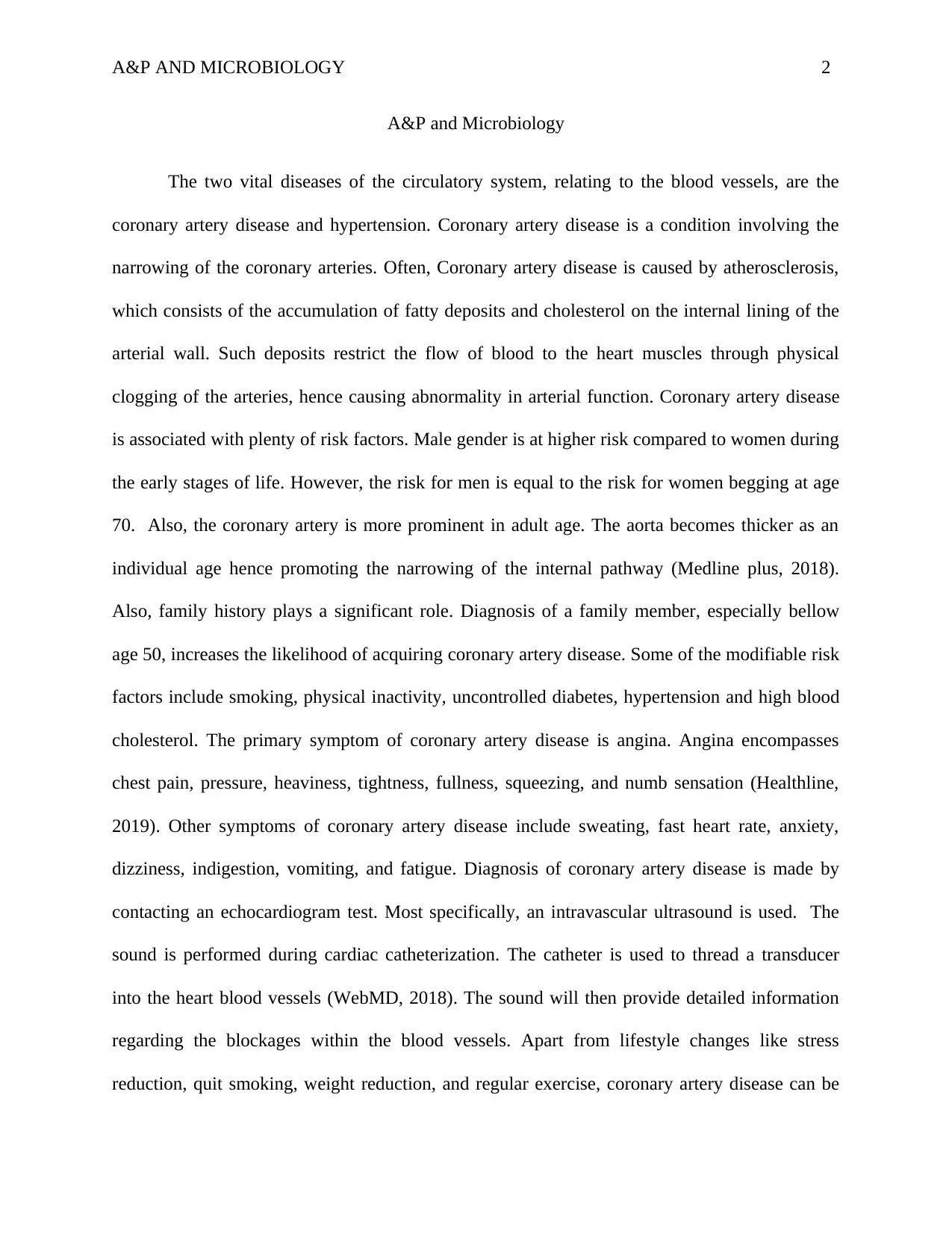
A&P AND MICROBIOLOGY 2
A&P and Microbiology
The two vital diseases of the circulatory system, relating to the blood vessels, are the
coronary artery disease and hypertension. Coronary artery disease is a condition involving the
narrowing of the coronary arteries. Often, Coronary artery disease is caused by atherosclerosis,
which consists of the accumulation of fatty deposits and cholesterol on the internal lining of the
arterial wall. Such deposits restrict the flow of blood to the heart muscles through physical
clogging of the arteries, hence causing abnormality in arterial function. Coronary artery disease
is associated with plenty of risk factors. Male gender is at higher risk compared to women during
the early stages of life. However, the risk for men is equal to the risk for women begging at age
70. Also, the coronary artery is more prominent in adult age. The aorta becomes thicker as an
individual age hence promoting the narrowing of the internal pathway (Medline plus, 2018).
Also, family history plays a significant role. Diagnosis of a family member, especially bellow
age 50, increases the likelihood of acquiring coronary artery disease. Some of the modifiable risk
factors include smoking, physical inactivity, uncontrolled diabetes, hypertension and high blood
cholesterol. The primary symptom of coronary artery disease is angina. Angina encompasses
chest pain, pressure, heaviness, tightness, fullness, squeezing, and numb sensation (Healthline,
2019). Other symptoms of coronary artery disease include sweating, fast heart rate, anxiety,
dizziness, indigestion, vomiting, and fatigue. Diagnosis of coronary artery disease is made by
contacting an echocardiogram test. Most specifically, an intravascular ultrasound is used. The
sound is performed during cardiac catheterization. The catheter is used to thread a transducer
into the heart blood vessels (WebMD, 2018). The sound will then provide detailed information
regarding the blockages within the blood vessels. Apart from lifestyle changes like stress
reduction, quit smoking, weight reduction, and regular exercise, coronary artery disease can be
A&P and Microbiology
The two vital diseases of the circulatory system, relating to the blood vessels, are the
coronary artery disease and hypertension. Coronary artery disease is a condition involving the
narrowing of the coronary arteries. Often, Coronary artery disease is caused by atherosclerosis,
which consists of the accumulation of fatty deposits and cholesterol on the internal lining of the
arterial wall. Such deposits restrict the flow of blood to the heart muscles through physical
clogging of the arteries, hence causing abnormality in arterial function. Coronary artery disease
is associated with plenty of risk factors. Male gender is at higher risk compared to women during
the early stages of life. However, the risk for men is equal to the risk for women begging at age
70. Also, the coronary artery is more prominent in adult age. The aorta becomes thicker as an
individual age hence promoting the narrowing of the internal pathway (Medline plus, 2018).
Also, family history plays a significant role. Diagnosis of a family member, especially bellow
age 50, increases the likelihood of acquiring coronary artery disease. Some of the modifiable risk
factors include smoking, physical inactivity, uncontrolled diabetes, hypertension and high blood
cholesterol. The primary symptom of coronary artery disease is angina. Angina encompasses
chest pain, pressure, heaviness, tightness, fullness, squeezing, and numb sensation (Healthline,
2019). Other symptoms of coronary artery disease include sweating, fast heart rate, anxiety,
dizziness, indigestion, vomiting, and fatigue. Diagnosis of coronary artery disease is made by
contacting an echocardiogram test. Most specifically, an intravascular ultrasound is used. The
sound is performed during cardiac catheterization. The catheter is used to thread a transducer
into the heart blood vessels (WebMD, 2018). The sound will then provide detailed information
regarding the blockages within the blood vessels. Apart from lifestyle changes like stress
reduction, quit smoking, weight reduction, and regular exercise, coronary artery disease can be
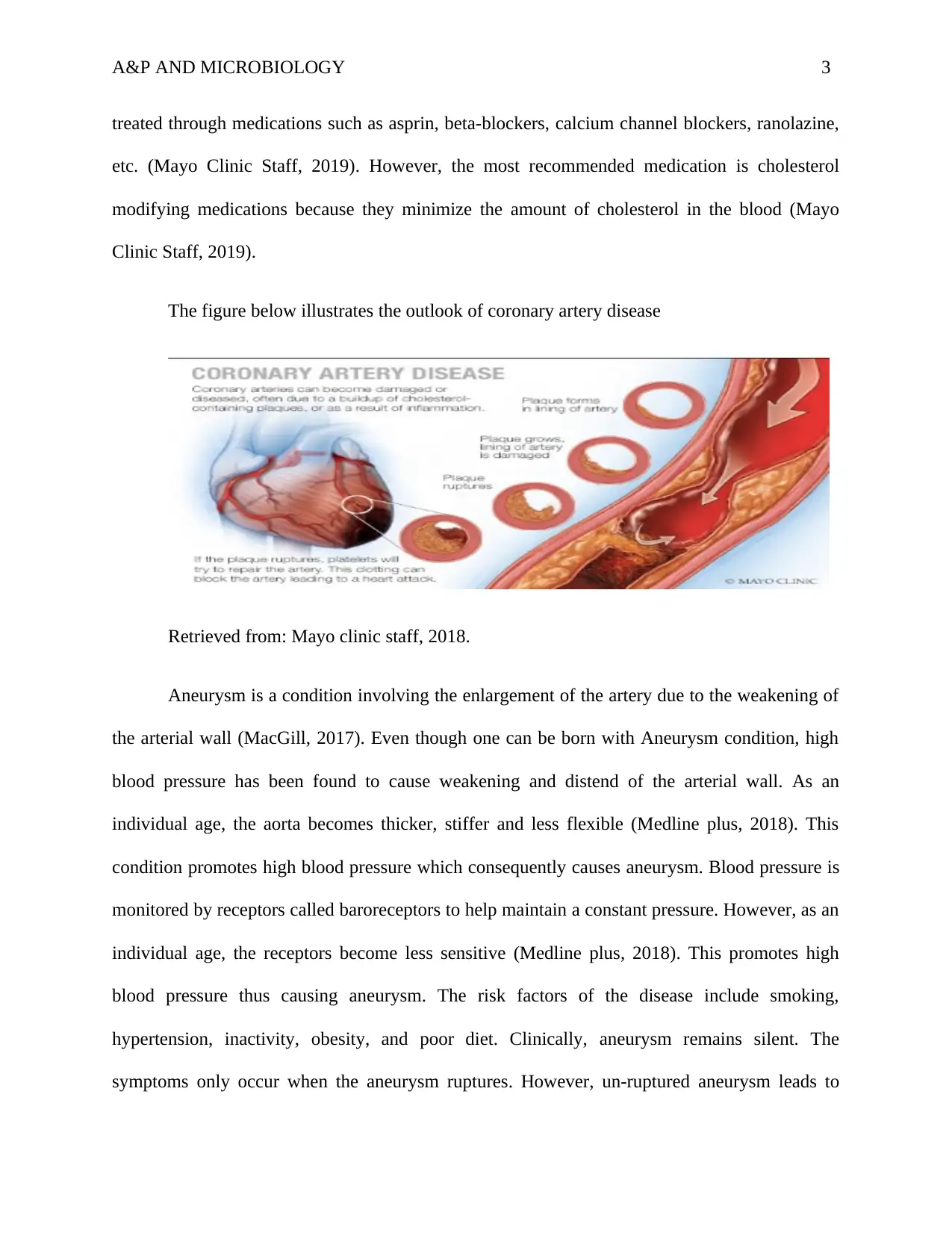
A&P AND MICROBIOLOGY 3
treated through medications such as asprin, beta-blockers, calcium channel blockers, ranolazine,
etc. (Mayo Clinic Staff, 2019). However, the most recommended medication is cholesterol
modifying medications because they minimize the amount of cholesterol in the blood (Mayo
Clinic Staff, 2019).
The figure below illustrates the outlook of coronary artery disease
Retrieved from: Mayo clinic staff, 2018.
Aneurysm is a condition involving the enlargement of the artery due to the weakening of
the arterial wall (MacGill, 2017). Even though one can be born with Aneurysm condition, high
blood pressure has been found to cause weakening and distend of the arterial wall. As an
individual age, the aorta becomes thicker, stiffer and less flexible (Medline plus, 2018). This
condition promotes high blood pressure which consequently causes aneurysm. Blood pressure is
monitored by receptors called baroreceptors to help maintain a constant pressure. However, as an
individual age, the receptors become less sensitive (Medline plus, 2018). This promotes high
blood pressure thus causing aneurysm. The risk factors of the disease include smoking,
hypertension, inactivity, obesity, and poor diet. Clinically, aneurysm remains silent. The
symptoms only occur when the aneurysm ruptures. However, un-ruptured aneurysm leads to
treated through medications such as asprin, beta-blockers, calcium channel blockers, ranolazine,
etc. (Mayo Clinic Staff, 2019). However, the most recommended medication is cholesterol
modifying medications because they minimize the amount of cholesterol in the blood (Mayo
Clinic Staff, 2019).
The figure below illustrates the outlook of coronary artery disease
Retrieved from: Mayo clinic staff, 2018.
Aneurysm is a condition involving the enlargement of the artery due to the weakening of
the arterial wall (MacGill, 2017). Even though one can be born with Aneurysm condition, high
blood pressure has been found to cause weakening and distend of the arterial wall. As an
individual age, the aorta becomes thicker, stiffer and less flexible (Medline plus, 2018). This
condition promotes high blood pressure which consequently causes aneurysm. Blood pressure is
monitored by receptors called baroreceptors to help maintain a constant pressure. However, as an
individual age, the receptors become less sensitive (Medline plus, 2018). This promotes high
blood pressure thus causing aneurysm. The risk factors of the disease include smoking,
hypertension, inactivity, obesity, and poor diet. Clinically, aneurysm remains silent. The
symptoms only occur when the aneurysm ruptures. However, un-ruptured aneurysm leads to
⊘ This is a preview!⊘
Do you want full access?
Subscribe today to unlock all pages.

Trusted by 1+ million students worldwide
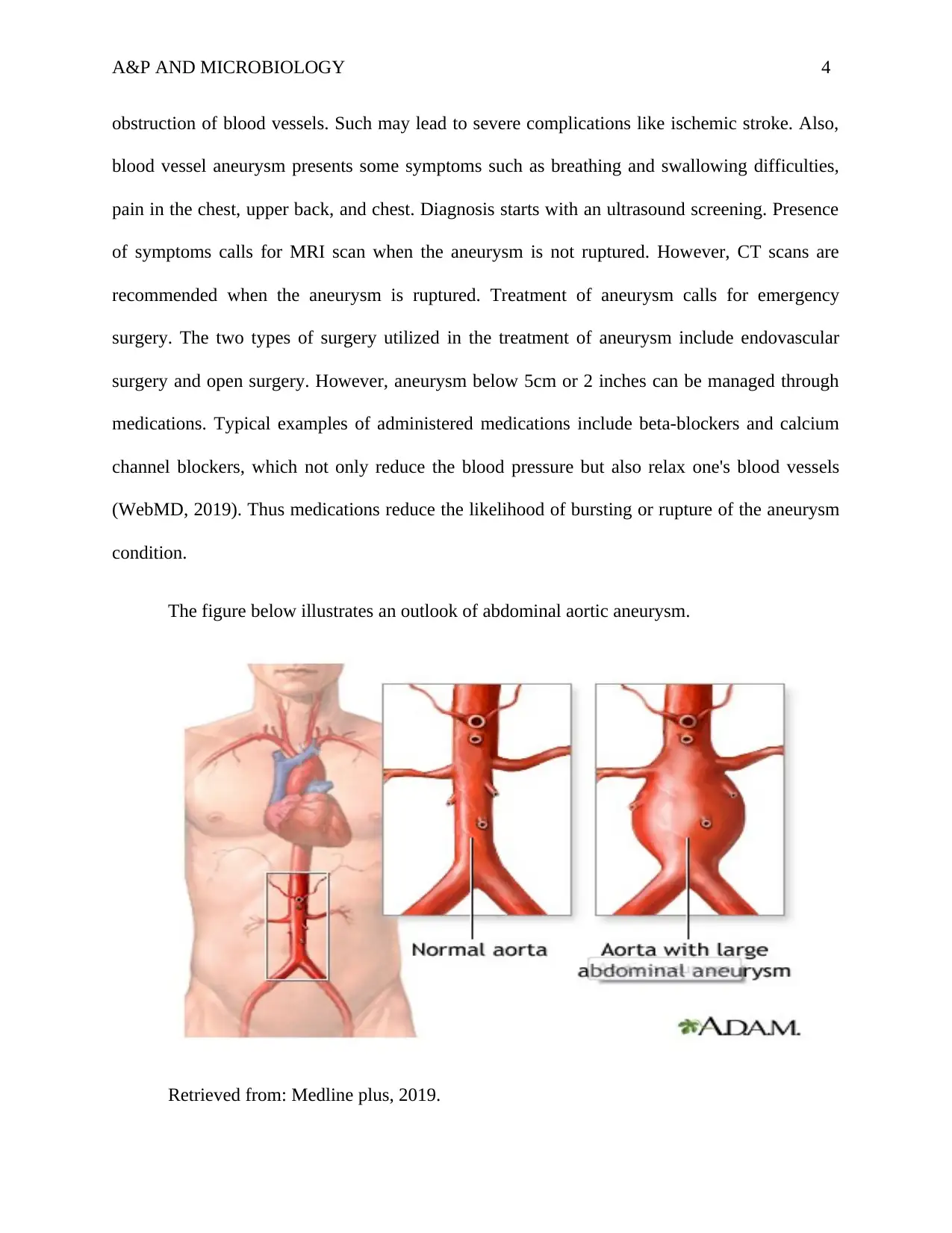
A&P AND MICROBIOLOGY 4
obstruction of blood vessels. Such may lead to severe complications like ischemic stroke. Also,
blood vessel aneurysm presents some symptoms such as breathing and swallowing difficulties,
pain in the chest, upper back, and chest. Diagnosis starts with an ultrasound screening. Presence
of symptoms calls for MRI scan when the aneurysm is not ruptured. However, CT scans are
recommended when the aneurysm is ruptured. Treatment of aneurysm calls for emergency
surgery. The two types of surgery utilized in the treatment of aneurysm include endovascular
surgery and open surgery. However, aneurysm below 5cm or 2 inches can be managed through
medications. Typical examples of administered medications include beta-blockers and calcium
channel blockers, which not only reduce the blood pressure but also relax one's blood vessels
(WebMD, 2019). Thus medications reduce the likelihood of bursting or rupture of the aneurysm
condition.
The figure below illustrates an outlook of abdominal aortic aneurysm.
Retrieved from: Medline plus, 2019.
obstruction of blood vessels. Such may lead to severe complications like ischemic stroke. Also,
blood vessel aneurysm presents some symptoms such as breathing and swallowing difficulties,
pain in the chest, upper back, and chest. Diagnosis starts with an ultrasound screening. Presence
of symptoms calls for MRI scan when the aneurysm is not ruptured. However, CT scans are
recommended when the aneurysm is ruptured. Treatment of aneurysm calls for emergency
surgery. The two types of surgery utilized in the treatment of aneurysm include endovascular
surgery and open surgery. However, aneurysm below 5cm or 2 inches can be managed through
medications. Typical examples of administered medications include beta-blockers and calcium
channel blockers, which not only reduce the blood pressure but also relax one's blood vessels
(WebMD, 2019). Thus medications reduce the likelihood of bursting or rupture of the aneurysm
condition.
The figure below illustrates an outlook of abdominal aortic aneurysm.
Retrieved from: Medline plus, 2019.
Paraphrase This Document
Need a fresh take? Get an instant paraphrase of this document with our AI Paraphraser
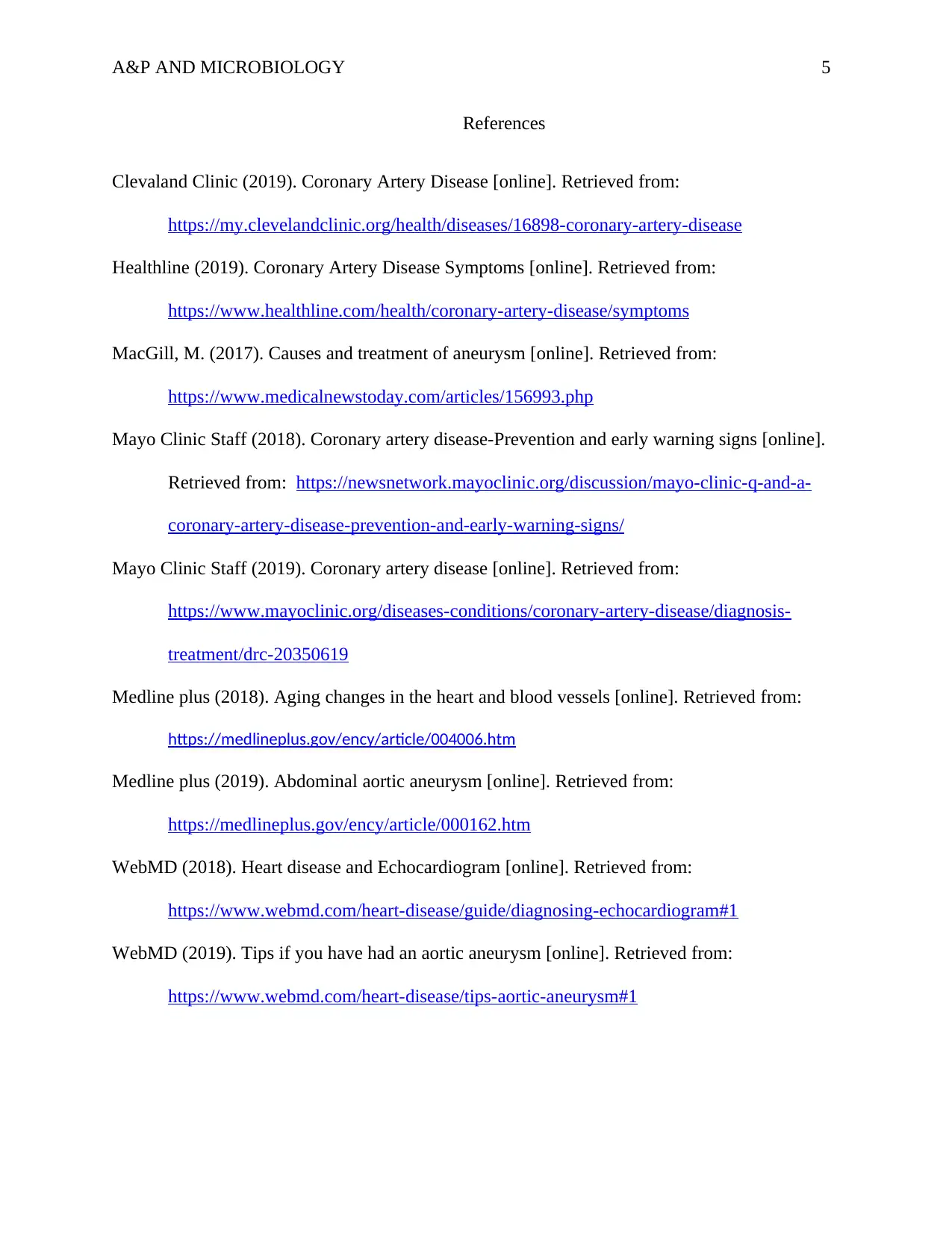
A&P AND MICROBIOLOGY 5
References
Clevaland Clinic (2019). Coronary Artery Disease [online]. Retrieved from:
https://my.clevelandclinic.org/health/diseases/16898-coronary-artery-disease
Healthline (2019). Coronary Artery Disease Symptoms [online]. Retrieved from:
https://www.healthline.com/health/coronary-artery-disease/symptoms
MacGill, M. (2017). Causes and treatment of aneurysm [online]. Retrieved from:
https://www.medicalnewstoday.com/articles/156993.php
Mayo Clinic Staff (2018). Coronary artery disease-Prevention and early warning signs [online].
Retrieved from: https://newsnetwork.mayoclinic.org/discussion/mayo-clinic-q-and-a-
coronary-artery-disease-prevention-and-early-warning-signs/
Mayo Clinic Staff (2019). Coronary artery disease [online]. Retrieved from:
https://www.mayoclinic.org/diseases-conditions/coronary-artery-disease/diagnosis-
treatment/drc-20350619
Medline plus (2018). Aging changes in the heart and blood vessels [online]. Retrieved from:
https://medlineplus.gov/ency/article/004006.htm
Medline plus (2019). Abdominal aortic aneurysm [online]. Retrieved from:
https://medlineplus.gov/ency/article/000162.htm
WebMD (2018). Heart disease and Echocardiogram [online]. Retrieved from:
https://www.webmd.com/heart-disease/guide/diagnosing-echocardiogram#1
WebMD (2019). Tips if you have had an aortic aneurysm [online]. Retrieved from:
https://www.webmd.com/heart-disease/tips-aortic-aneurysm#1
References
Clevaland Clinic (2019). Coronary Artery Disease [online]. Retrieved from:
https://my.clevelandclinic.org/health/diseases/16898-coronary-artery-disease
Healthline (2019). Coronary Artery Disease Symptoms [online]. Retrieved from:
https://www.healthline.com/health/coronary-artery-disease/symptoms
MacGill, M. (2017). Causes and treatment of aneurysm [online]. Retrieved from:
https://www.medicalnewstoday.com/articles/156993.php
Mayo Clinic Staff (2018). Coronary artery disease-Prevention and early warning signs [online].
Retrieved from: https://newsnetwork.mayoclinic.org/discussion/mayo-clinic-q-and-a-
coronary-artery-disease-prevention-and-early-warning-signs/
Mayo Clinic Staff (2019). Coronary artery disease [online]. Retrieved from:
https://www.mayoclinic.org/diseases-conditions/coronary-artery-disease/diagnosis-
treatment/drc-20350619
Medline plus (2018). Aging changes in the heart and blood vessels [online]. Retrieved from:
https://medlineplus.gov/ency/article/004006.htm
Medline plus (2019). Abdominal aortic aneurysm [online]. Retrieved from:
https://medlineplus.gov/ency/article/000162.htm
WebMD (2018). Heart disease and Echocardiogram [online]. Retrieved from:
https://www.webmd.com/heart-disease/guide/diagnosing-echocardiogram#1
WebMD (2019). Tips if you have had an aortic aneurysm [online]. Retrieved from:
https://www.webmd.com/heart-disease/tips-aortic-aneurysm#1
1 out of 5
Related Documents
Your All-in-One AI-Powered Toolkit for Academic Success.
+13062052269
info@desklib.com
Available 24*7 on WhatsApp / Email
![[object Object]](/_next/static/media/star-bottom.7253800d.svg)
Unlock your academic potential
Copyright © 2020–2025 A2Z Services. All Rights Reserved. Developed and managed by ZUCOL.





